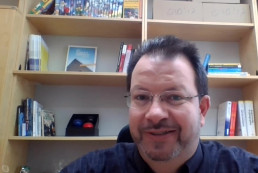Recollections of viewers
Lothar Fritsch during his interview via video call
Usenet was the most important discussion platform on the Internet in the 1990s. Before the emergence of the World Wide Web, people discussed and exchanged ideas here in thousands of forums organized by topic. The newsgroup’s name, de.soc.kultur, signals what it’s all about: it’s a German-language group (de) in which social issues (soc = society) and, in this case, cultural topics, are discussed. On June 22, 1992, a week after “Piazza virtuale” began broadcasting, Lothar Fritsch, then a computer science student at Saarland University, wrote a detailed review of the program. Almost thirty years later, we interviewed him, who now teaches computer science at Oslo Metropolitan University in Oslo, about his memories of the program.
